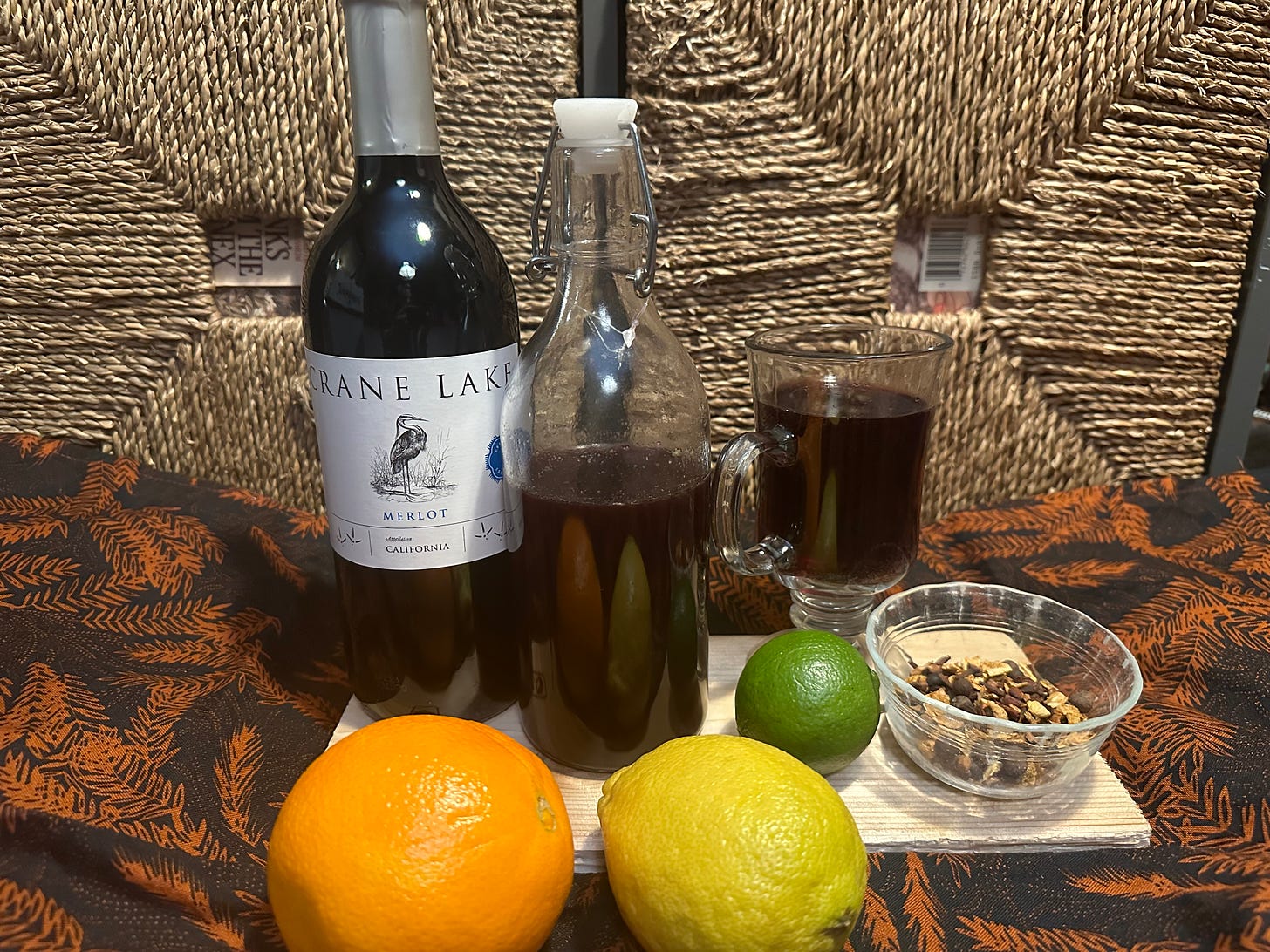Greetings, Wonketeers! I’m Hooper, your bartender. Black Friday’s in the rearview mirror, and the holiday season has officially kicked off. Let’s begin by hitting the classics. I’ve got a plan for mulled wine that should help keep you merry all winter long. Let’s make ourselves some Smoking Bishop. Here’s the recipe:
Smoking Bishop
5 oz. Crane Lake Merlot (one wine glass)
1 oz. mulled wine base
Gently warm the wine to a drinkable temperature. Add syrup and stir. Garnish with an orange twist or spice as desired.
Mulled Wine Base
1 cup sugar
2 oranges
1 lemon
1 lime
4 cloves
1 cinnamon stick, 3”
¼ t vanilla
¼ t grated nutmeg
2 star anise pods
1 cup Crane Lake Merlot
Peel the lemon, lime, and oranges, avoiding the white pith. Add fruit peel, spices, and sugar to a saucepan. Add 1 cup of wine. Simmer, stirring occasionally, until the sugar is completely dissolved, 15-20 minutes. Squeeze the juice of one orange into the mixture. Strain and pour into an airtight bottle for later use. Store in the refrigerator.
Mulled wine is an old, old recipe, a good idea that dates back to the Greeks. Warmed-up cheap wine, spices, and sugar: always a good idea. Charles Dickens cemented the idea that mulled wine was for the holidays when a newly-merrified Scrooge tells Bob Cratchitt, “… we will discuss your affairs this very afternoon, over a Christmas bowl of Smoking Bishop, Bob!” But there’s no reason not to enjoy this treat all winter long.
I will note that I’m cheating a bit here. Period recipes exist for Smoking Bishop, but they don’t make sense to me in places and seem far too sweet for a modern palate. I’m shamelessly stealing the name for my own, modern take on mulled wine; my tiki-infused soul just can’t pass up a cool name for a cocktail. My apologies to the purists.
The biggest challenge I find with standard mulled wine recipes is the heat and the timing. Generally, mulled wine gets served at a Christmas party. You add sugar, wine, and spices to a crock pot, bring the mixture to a simmer, and let guests serve themselves. But as the evening goes on, the heat will boil off the alcohol and concentrate the spices and tannins in the wine, leaving you with a bitter, overspiced drink. Building a spiced wine syrup lets you stabilize the spice levels and hold onto the punch until service. It also means that you don’t have to simmer the wine to gain flavor from the mulling spice; you can simply heat the wine until it’s at a drinkable temperature, toss in the wine syrup, and call it good.
Best of all, you aren’t obligated to throw a party to enjoy mulled wine. Use the whole bottle of syrup with a bottle of wine if you’re throwing a party. But if you just want a pick-me-up after a rough day, warm some wine in the microwave and toss in a splash of syrup. It’s the perfect accompaniment to your breakfast stollen on a cold winter morning.
Let’s talk ingredients:

Sugar: Pure white is probably best. The Greeks and Romans would have used honey, but a full cup of honey here would overwhelm some flavors (and would be pretty expensive to boot). I do like the idea of swapping some sugar for honey; if you’re a classicist, I’d experiment a little to see if it suits your palate.
Citrus: Note that we’re using all of the fruit peels in this beverage, but only the juice of the oranges. If you’ve been playing along at home with my cocktails, I’m sure you can find a good place for fresh lemon and lime juice. Try to scrape off as little pith from the fruit as possible; a good horizontal peeler from OXO is very helpful.
Spices: You’re allowed to go freeform here. Cinnamon and a little clove are probably mandatory, but ginger and allspice do show up from time to time. The vanilla and star anise are probably optional. Add whatever spices make up your Christmas potpourri, and you’ll do fine. I used a mix that features cinnamon, clove, and allspice. (Do not *actually* add potpourri to the wine. That would probably be bad.)
Merlot: If there was ever a perfect home for the infamous “Two Buck Chuck” from Trader Joe’s, this would be it. Any cheap, tasty red wine will do the trick here; I often use Crane Lake from the local grocery store. The most important thing is to use a low-tannin wine, like Merlot or Zinfandel. The bitter tannins will concentrate in the syrup, so using a tannin bomb like Cabernet Sauvignon will probably be a mistake. Likewise, the wine that you’re adding the syrup to should be fairly soft.
The original Smoking Bishop used port wine as its base. Victorians loved their port, but the notion of adding a cup of sugar to a bottle of port wine makes my teeth hurt. It would be painfully sweet. The historic recipe I found for Smoking Bishop called for boiling the sugared wine and then setting it on fire, which makes no sense. The alcohol would boil off rapidly, which suggests you’re brûléeing a syrup instead of lighting alcohol. This seems like a great way to ruin a pan and enrage your insurance company.
On the subject of alcohol, this drink would weather a little fortification just fine. A half-ounce of rum or brandy in the glass will be enough to make things a little merrier. Add any extra booze at the last minute, to keep it from cooking off.
In summary and conclusion, drink well, drink often, and tip your bartender — donate to Wonkette at the link below!
If you’re buying cocktail implements and whatnot at Amazon, this button gives us a small commission!
You can find me on Threads and Insta at samurai_grog!
OPEN THREAD!
























































![Key Metrics for Social Media Marketing [Infographic] Key Metrics for Social Media Marketing [Infographic]](https://www.socialmediatoday.com/imgproxy/nP1lliSbrTbUmhFV6RdAz9qJZFvsstq3IG6orLUMMls/g:ce/rs:fit:770:435/bG9jYWw6Ly8vZGl2ZWltYWdlL3NvY2lhbF9tZWRpYV9yb2lfaW5vZ3JhcGhpYzIucG5n.webp)






















